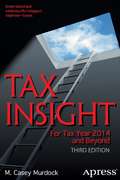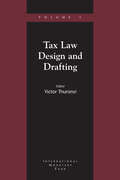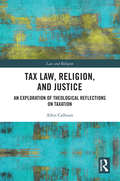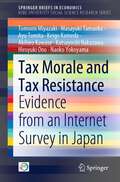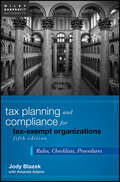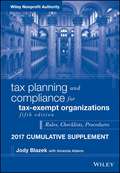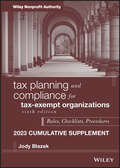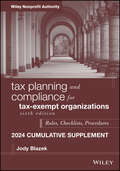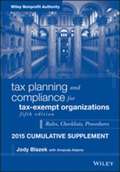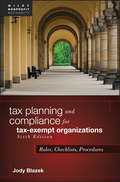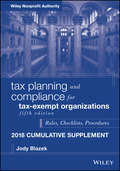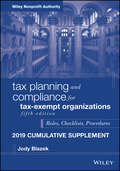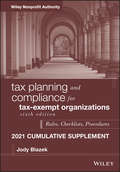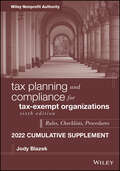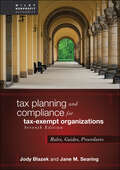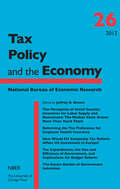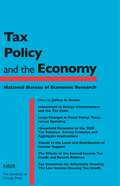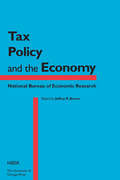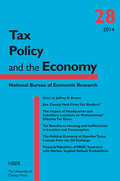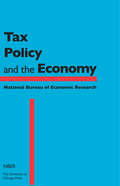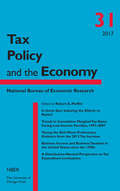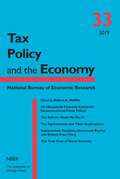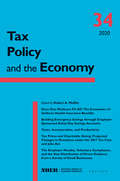- Table View
- List View
Tax Insight: For Tax Year 2014 and Beyond
by M. Casey MurdockTax Insight: For Tax Year 2014 and Beyond will teach you to take control of life’s biggest expense—taxes. In your lifetime, you will spend more money on taxes than on anything else. Despite that fact, you likely know the current prices of movies and milk but don’t know what your marginal tax rate is. You know where to get the cheapest gallon of gas to save a buck or two, but you don’t give a thought to the tax strategies you should be using right now that would save you thousands. It's not hard to understand why--taxes are complicated, unpleasant, and confusing. In Tax Insight, tax expert Casey Murdock opens up the world of taxes with amazing clarity and simplicity. As you will discover, you have within reach numerous ways to reduce your taxes. With everyday language and real-life examples, Tax Insight will give you the keys to minimizing your tax burden. This book contains information you need even if you have a tax advisor or use a program like TurboTax. Tax professionals are busy and sometimes too cautious, and programs often miss opportunities for you to save money. It's also for those of all ages and income levels, including business owners. Tax Insight: Breaks down the key components of taxes with ease and simplicity. Provides a roadmap to paying as little tax as possible. Helps you know if you should do it yourself or hire a professional. While there are many encyclopedic books on taxes—like J.K. Lasser’s Your Taxes—there aren’t nearly enough that describe the tax code in plain language. Far more than a rehash of impenetrable IRS "help" documents, Tax Insight is organized the way most people think and presents ideas in clear, simple language. If you buy this book and take advantage of its advice, you will save money. What you’ll learn This book will help you: Avoid paying even a penny more in taxes than you should. Avoid common tax strategies that could actually cost you more than they save. Capture all of the deductions and credits that you are due. Know whether to file your own return or hire a tax professional. Utilize the entire year to implement tax-reducing strategies. Understand the key components of the tax return and how they work together. Prepare for or survive an audit Use real estate or a small business to reduce your tax bill Who this book is for Pay Less Tax: For Tax Year 2014 and Beyond is for the frustrated taxpayer—the taxpayer who is frustrated by paying too much, frustrated by the complexity of the tax code, or frustrated because their CPA isn’t proactively helping them pay fewer taxes. Pay Less Tax is the perfect book for the person who is looking for a straightforward, simple explanation of the tax-saving strategies that are within reach. In an easy-to-read, easy-to-understand narrative, Pay Less Tax gives readers a thorough understanding of the tax strategies that apply to them and the information they need to put those strategies to work.
Tax Law Design and Drafting, Volume 1: [subtitle]
by Victor T ThuronyiA report from the International Monetary Fund.
Tax Law, Religion, and Justice: An Exploration of Theological Reflections on Taxation (Law and Religion)
by Allen CalhounThis book asks why tax policy is both attracted to and repelled by the idea of justice. Accepting the invitation of economist Henry Simons to acknowledge that tax justice is a theological concept, the work explores theological doctrines of taxation to answer the presenting question. The overall message of the book is that taxation is an instrument of justice, but only when taxes take into account multiple goods in society: the requirements of the government, the property rights of society’s members, and the material needs of the poor. It is argued that this answer to the presenting question is a theological and ethical answer in that it derives from the insistence of Christian thinkers that tax policy take into account material human need (necessitas). Without the necessitas component of the tax balance, tax systems end up honoring only one of the three components of the tax equation and cease to reflect a coherent idea of justice. The book will be of interest to academics and researchers working in the areas of tax law, economics, theology, and history.
Tax Morale and Tax Resistance: Evidence from an Internet Survey in Japan (SpringerBriefs in Economics)
by Keigo Kameda Tomomi Miyazaki Masayuki Tamaoka Ayu Tomita Akihiro Kawase Katsuyoshi Nakazawa Hiroyuki Ono Naoko YokoyamaThis book is the first to shed light on the recent opinion of taxpayers on tax and fiscal policy in Japan through an attitude questionnaire. It is said that Japanese taxpayers’ tax morale is high. However, taxpayers in Japan are often described as having strong resistance to tax increases, especially consumption tax increases. There is, then, a paradox with respect to the attitude toward tax policies among Japanese citizens. This book provides background information and basic descriptive statistics from Internet surveys in Japan by the authors, who introduce their results by focusing on tax morale and opinions with respect to a consumption tax hike. The summary statistics indicate that while tax morale is high, half of the respondents oppose a consumption tax hike from 8% to 10%. Furthermore, the ideal consumption tax rate for most respondents was less than 10% in both surveys, suggesting that Japanese taxpayers have a strong tax resistance, attributable to distrust of government and politicians.
Tax Planning and Compliance for Tax-Exempt Organizations
by Jody Blazek Amanda AdamsAn essential, timesaving guide for accountants, lawyers, nonprofit executives and directors, consultants, and volunteersThis book is an indispensable guide to navigating the complex maze of nonprofit tax rules and regulations. A clear and fully cited description of the requirements for the various categories of tax-exempt entities from public charities, private foundations, civic associations, business leagues, and social clubs to title-holding companies and governmental entities can be found. Practical guidance on potential for income tax on revenue-producing enterprises along with explanations of many exceptions to taxability is provided. Issues raised by Internet activity, advertising, publishing, providing services, and much more are explained.This useful guide covers the many significant issues facing nonprofit organizations, including compensation and possible private inurement, affiliation, separations and mergers, donor disclosures, lobbying and electioneering, and employment taxes.Offers a supplemental, annual update to keep subscribers current on relevant changes in IRS forms, requirements, and related tax proceduresIncludes easy-to-use checklists highlighting such critical concerns as tax-exempt eligibility, reporting to the IRS, and comprehensive tax compliance issuesFeatures a variety of sample documents for private foundations, including penalty abatement requests and sharing space agreementsProvides helpful practice aids, such as a comparison of the differences between public and private charities, charts reflecting lobbying limits for different types of entities, and listings of rulings and cases that illustrate permissible activity for each type of organizations compared to impermissible activityFilled with practical tips and suggestions for handling such critical situations as preparing for and surviving an IRS examination, Tax Planning and Compliance for Tax-Exempt Organizations, Fifth Edition provides guidance for the significant issues facing nonprofit organizations.
Tax Planning and Compliance for Tax-Exempt Organizations 2016 Cumulative Supplement
by Jody Blazek Amanda AdamsAn essential, timesaving guide for accountants, lawyers, nonprofit executives and directors, consultants, and volunteers, the Tax Planning and Compliance for Tax-Exempt Organizations: Rules, Checklists, and Procedures, Fifth Edition is an indispensable guide to navigating the complex maze of nonprofit tax rules and regulations. Along with clear, concise instructions for filing Forms 990 and other important IRS forms and documents, this practical guide covers the significant issues facing nonprofit organizations, including unrelated business income, private inurement, affiliations, and employment taxes. It also provides practical guidance on obtaining the tax exemption; reporting to boards, auditors, and the IRS; testing ongoing tax compliance; and managing lobbying expenditure.
Tax Planning and Compliance for Tax-Exempt Organizations, 2023 Cumulative Supplement: 2016 Cumulative Supplement (Wiley Nonprofit Authority Ser. #239)
by Jody BlazekAn essential, timesaving guide for accountants, lawyers, nonprofit executives and directors, consultants, and volunteers – Completely updated for 2023 This book is an indispensable guide to navigating the complex maze of nonprofit tax rules and regulations. A clear and fully cited description of the requirements for the various categories of tax-exempt entities from public charities, private foundations, civic associations, business leagues, and social clubs to title-holding companies and governmental entities can be found. Practical guidance on potential for income tax on revenue-producing enterprises along with explanations of many exceptions to taxability is provided. Issues raised by Internet activity, advertising, publishing, providing services, and much more are explained. This useful annual supplement for 2023 will cover any and all changes and updates to the law within the previous 12 month period and will keep accountants, attorneys, and others up-to-date for the year ahead. Features a variety of sample documents for private foundations, including penalty abatement requests and sharing space agreements Provides helpful practice aids, such as a comparison of the differences between public and private charities, charts reflecting lobbying limits for different types of entities, and listings of rulings and cases that illustrate permissible activity for each type of organizations compared to impermissible activity
Tax Planning and Compliance for Tax-Exempt Organizations, 2024 Cumulative Supplement: 2016 Cumulative Supplement (Wiley Nonprofit Authority Ser. #239)
by Jody Blazek Jane M. SearingAn essential resource for the legal and finance professionals serving US-based tax-exempt organizations In the 2024 Cumulative Supplement to the latest edition of Tax Planning and Compliance for Tax-Exempt Organizations, a team of dedicated legal and accounting professionals delivers a timely and current discussion of the latest rules, pronouncements, legislation, and regulations affecting tax-exempt entities. In this Supplement, you'll discover clear and fully cited and supported descriptions of the requirements for a variety of categories of tax-exempt organizations, including public charities, private foundations, civic associations, business leagues, and social clubs. In this update, you'll find: Coverage of every relevant and significant change to the taxation law governing tax-exempt organizations Various sample documents and practice aids to save time and energy in the preparation of this year's financial documents Practical guidance on the potential for income tax on revenue-producing enterprises Perfect for accountants, lawyers, executives, directors, and volunteers serving one of the many tax-exempt entities in the United States, Tax Planning and Compliance for Tax-Exempt Organizations: 2024 Cumulative Supplement is also an essential resource for consultants, managers, and other professionals working in or for tax-exempt organizations.
Tax Planning and Compliance for Tax-Exempt Organizations, Fifth Edition 2015 Cumulative Supplement
by Jody BlazekThe essential nonprofit tax guide, updated with the latest rules and requirements The 2015 Cumulative Supplement to Tax Planning and Compliance for Tax-Exempt Organizations is the latest addition to the indispensable guide to navigating nonprofit tax issues stemming from evolving regulations and IRS procedures. This most recent supplement is packed with checklists and examples that ease the filing process. This new supplement is updated to align with the relevant changes in IRS forms, requirements, and procedures to help you ensure full compliance with the most up-to-date regulations. Clear, concise instructions guide you through important forms and documents, and expert discussion provides insight on specific issues such as unrelated business income, private inurement, affiliations, and employment taxes. Helpful checklists highlight critical concerns, sample documents provide clarification and example, and the nonprofit-specific guidance leads you through obtaining tax exemption, reporting, compliance testing, and lobbying expenditure management. Nonprofit organizations contend with the possibility of losing their tax-exempt status on a daily basis. Qualification, application, maintenance, and management--every aspect of that vital status requires a solidly executed strategy for ensuring compliance with federal, state, and local regulations. The 2015 Cumulative Supplement helps you put your strategy into action, with a host of valuable tools and expert guidance on the practical aspect of nonprofit tax planning. Follow line-by-line instructions for forms and applications Access easy checklists for reporting, compliance, eligibility, and more Examine sample bylaws, applications, and forms Utilize comparison charts and other visual aids for easy reference Review bullet lists that compare what is and what is not acceptable Tax rules and regulations change annually, and nonprofit organizations know that staying compliant means staying up to date. Wading through tax code is less than helpful in the field where clear, practically oriented instruction provides the quick reference accountants, lawyers, and executives need. The 2015 Cumulative Supplement to Tax Planning and Compliance for Tax-Exempt Organizations is the essential, time-saving guide to the latest in nonprofit tax rules, regulations, and procedures.
Tax Planning and Compliance for Tax-Exempt Organizations: Rules, Checklists, Procedures (Wiley Nonprofit Authority #239)
by Jody BlazekA practical guide to handling the challenges facing tax-exempt organizations, written by a leading authority Tax Planning and Compliance for Tax-Exempt Organizations, Sixth Edition ensures that you have the practical knowledge to handle critical tax situations. This book provides guidance for the significant issues facing nonprofit organizations. It’s an essential guide to navigating the complexities of nonprofit tax rules and regulations. Packed with checklists and suggestions starting with Exhibit 1.1, Organizations Reference Chart and Exhibit 1.2, Suitability for Tax-Exempt Status, this guide helps anyone that creates, advises, or manages a nonprofit organization. Now, you can better understand the requirements for various categories of tax-exempt organizations: public charities, private foundations, civic associations, business leagues, and social clubs, as well as title-holding companies and governmental entities. You’ll discover practical guidance on the issue of potentially owing income tax on revenue-producing enterprises. Clear explanations cover the many exceptions to taxability. Tax issues related to internet activity, advertising, publishing, services, and much more are all addressed in this tax planning guide designed specifically for nonprofit and tax-exempt nonprofit organizations. Use extensive quick checklists that cover tax-exempt eligibility, reporting to the IRS, and tax compliance Find detailed instructions for submitting a variety of exemption applications and tax forms See sample documents, such as organizational bylaws, letters of application, and completed IRS forms Refer to tools and practice aids, such as a comparison chart summarizing the differences between public and private charitable organizations Written by one of the leading authorities in the field, the book also delves into recent tax law changes affecting nonprofits and other tax-exempt organizations. This indispensable guide can offer direction and support if you are challenged to successfully navigate the complex maze of nonprofit tax rules and regulations.
Tax Planning and Compliance for Tax-Exempt Organizations: Rules, Checklists, Procedures - 2018 Cumulative Supplement
by Jody BlazekThe essential time-saving guide to the latest in nonprofit tax rules, regulations, and procedures Tax rules and regulations change annually, and nonprofit organizations know that staying compliant means staying up to date. But wading through tax code is less than helpful in the field, whereas the clear, practically oriented instruction inside provides the quick reference accountants, lawyers, and executives need. In the latest edition of Tax Planning and Compliance for Tax-Exempt Organizations, you'll find straightforward information on changing Unrelated Business Income (UBI) rules, joint ventures, sponsorships, deductions against UBI, preparation of IRS forms, and more. Nonprofit organizations—including health and welfare organizations, colleges and universities, private foundations, churches, libraries, museums, cultural institutions, and other smaller groups—contend daily with the possibility of losing their tax-exempt status. From qualifying and applying for that status, to maintaining and managing it, every nonprofit organization must plan and monitor ongoing procedures, activities, and forms to comply with federal, state, and local regulations. Access easy checklists for reporting, compliance, eligibility, and more Examine sample bylaws, applications, and forms Utilize comparison charts and other visual aids for easy reference Review bullet lists that compare what is and what is not acceptable Tax Planning and Compliance for Tax-Exempt Organizations is an indispensable guide to navigating the complex maze of nonprofit tax rules and regulations.
Tax Planning and Compliance for Tax-Exempt Organizations: Rules, Checklists, Procedures, 2019 Cumulative Supplement (Wiley Nonprofit Authority #239)
by Jody BlazekAn essential, timesaving guide for accountants, lawyers, nonprofit executives and directors, consultants, and volunteers This book is an indispensable guide to navigating the complex maze of nonprofit tax rules and regulations. A clear and fully cited description of the requirements for the various categories of tax-exempt entities from public charities, private foundations, civic associations, business leagues, and social clubs to title-holding companies and governmental entities can be found. Practical guidance on potential for income tax on revenue-producing enterprises along with explanations of many exceptions to taxability is provided. Issues raised by Internet activity, advertising, publishing, providing services, and much more are explained. This useful guide covers the many significant issues facing nonprofit organizations, including compensation and possible private inurement, affiliation, separations and mergers, donor disclosures, lobbying and electioneering, and employment taxes. Offers a supplemental, annual update to keep subscribers current on relevant changes in IRS forms, requirements, and related tax procedures Includes easy-to-use checklists highlighting such critical concerns as tax-exempt eligibility, reporting to the IRS, and comprehensive tax compliance issues Features a variety of sample documents for private foundations, including penalty abatement requests and sharing space agreements Provides helpful practice aids, such as a comparison of the differences between public and private charities, charts reflecting lobbying limits for different types of entities, and listings of rulings and cases that illustrate permissible activity for each type of organizations compared to impermissible activity Filled with practical tips and suggestions for handling such critical situations as preparing for and surviving an IRS examination, Tax Planning and Compliance for Tax-Exempt Organizations, Fifth Edition provides guidance for the significant issues facing nonprofit organizations.
Tax Planning and Compliance for Tax-Exempt Organizations: Rules, Checklists, Procedures, 2021 Supplement (Wiley Nonprofit Authority Ser. #239)
by Jody BlazekStay informed about the latest legislative, regulatory, and case law developments in the area of tax-exempt organization taxation and compliance In the 2021 Supplement to the 6th edition of Tax Planning and Compliance for Tax-Exempt Organizations: Rules, Checklists, Procedures, readers will find authoritative guidance and insightful commentary on the latest regulatory and legislative changes affecting public charities, private foundations, civic associations, business leagues, and social clubs. The Supplement also includes comprehensive coverage of the most important cases and common law developments governing tax-exempt organizations, the managers who oversee them, and the professionals who advise them. Written by one of the leading authorities in the field, this latest update to a complex and rapidly evolving area of the law is an indispensable and reliable companion to the most recent edition of Tax Planning and Compliance for Tax-Exempt Organizations.
Tax Planning and Compliance for Tax-Exempt Organizations: Rules, Checklists, Procedures, 2022 Cumulative Supplement (Wiley Nonprofit Authority Ser. #239)
by Jody BlazekAn essential, timesaving guide for accountants, lawyers, nonprofit executives and directors, consultants, and volunteers – Completely updated for 2022 This book is an indispensable guide to navigating the complex maze of nonprofit tax rules and regulations. A clear and fully cited description of the requirements for the various categories of tax-exempt entities from public charities, private foundations, civic associations, business leagues, and social clubs to title-holding companies and governmental entities can be found. Practical guidance on potential for income tax on revenue-producing enterprises along with explanations of many exceptions to taxability is provided. Issues raised by Internet activity, advertising, publishing, providing services, and much more are explained. This useful annual supplement for 2022 will cover any and all changes and updates to the law within the previous 12 month period and will keep accountants, attorneys, and others up-to-date for the year ahead. Features a variety of sample documents for private foundations, including penalty abatement requests and sharing space agreements Provides helpful practice aids, such as a comparison of the differences between public and private charities, charts reflecting lobbying limits for different types of entities, and listings of rulings and cases that illustrate permissible activity for each type of organizations compared to impermissible activity
Tax Planning and Compliance for Tax-Exempt Organizations: Rules, Guides, Procedures (Wiley Nonprofit Authority)
by Jody Blazek Jane M. SearingA hands-on roadmap to navigating the complicated maze of tax-exempt rules and regulations In the newly revised seventh edition of Tax Planning and Compliance for Tax-Exempt Organizations: Rules, Checklists, Procedures, a team of celebrated tax and nonprofit specialists delivers a critical update to their widely read and authoritative series on nonprofit organization taxation. It's an essential guide to making sense of the complexities of nonprofit tax rules and regulations. Packed with checklists and suggestions, this book tells you exactly how to understand—and comply with—the complicated maze of tax-exempt organization rules and regulations administered by the Internal Revenue Service. In the book, you'll find: Extensive, quick-use checklists for determining tax-exempt eligibility, reporting to the IRS, and tax compliance Detailed instructions for submitting exemption applications and tax forms Sample documents, including organizational bylaws, letters of application, and completed IRS forms Tools and practice aids, like a comparison chart explaining the differences between public and private charities Written by two of the leading authorities in a rapidly evolving field, Tax Planning and Compliance for Tax-Exempt Organizations dives deep into the most recent changes to the tax code, new case law and IRS rulings, and regulations promulgated since 2020. It's perfect for tax and accounting professionals everywhere.
Tax Policy and the Economy, Volume 26 (National Bureau of Economic Research Tax Policy and the Economy #26)
by The University of Chicago PressThere is no question that the US is facing significant fiscal challenges. Tax Policy and the Economy research papers make valuable contributions to our understanding of the economic effects of alternative approaches. The papers collected in Volume 26 include a study of an important determinant of the labor supply effects of Social Security; an examination of the budgetary and economic impact of changing how employer health insurance is treated in the tax code; an analysis of how US investment in Europe might be impacted by proposed corporate tax reform in the European Union; a look at the term “tax expenditures,” often used to describe governmental policies that show as reduction in taxes rather than as an increase in spending. The final paper in the volume shows how uncertainty about the restoration of US fiscal balance imposes additional efficiency costs on the economy in consumption, saving, labor supply and portfolio decisions, and how it reduces individual welfare.
Tax Policy and the Economy, Volume 27 (National Bureau of Economic Research Tax Policy and the Economy)
by The University of Chicago PressTaxation policy was a central part of the policy debates over the “fiscal cliff.” Given the importance of fiscal issues, it is vital for rigorous empirical research to inform the policy dialogue. In keeping with the NBER’s tradition of carrying out rigorous but policy-relevant research, Volume 27 of Tax Policy and the Economy offers insights on a number of key tax policy questions. This year's volume features six papers by leading scholars who examine the tax treatment of tuition at private K-12 schools, the potential streamlining of the federal rules for post-secondary financial aid and the use of tax return information in this process, the effect of tax and benefit programs on incentives to work, the macroeconomic effects of fiscal adjustments, and the set of factors that contributed to the weakening US fiscal outlook in the last decade.
Tax Policy and the Economy, Volume 28
by Jeffrey R. BrownThe papers in Volume 28 of Tax Policy and the Economy illustrate the depth and breadth of the research by NBER research associates who study taxation and government spending programs. The first paper explores whether closely held firms are used as tax shelters. The second examines the taxation of multinational corporations. The third discusses the taxation of housing, focusing on the ways in which current income tax rules may affect location and consumption decisions and lead to economic inefficiencies. The fourth paper offers an historical perspective on the political economy of gasoline taxes, with a particular focus on the response to the oil shocks of the early 1970s. The fifth and final paper uses the tools of financial economics to estimate the unfunded liabilities of the Pension Benefit Guaranty Corporation.
Tax Policy and the Economy, Volume 28 (National Bureau of Economic Research Tax Policy and the Economy)
by The University of Chicago PressThe papers in Volume 28 of Tax Policy and the Economy illustrate the depth and breadth of the research by NBER research associates who study taxation and government spending programs. The first paper explores whether closely held firms are used as tax shelters. The second examines the taxation of multinational corporations. The third discusses the taxation of housing, focusing on the ways in which current income tax rules may affect location and consumption decisions and lead to economic inefficiencies. The fourth paper offers an historical perspective on the political economy of gasoline taxes, with a particular focus on the response to the oil shocks of the early 1970s. The fifth and final paper uses the tools of financial economics to estimate the unfunded liabilities of the Pension Benefit Guaranty Corporation.
Tax Policy and the Economy, Volume 29 (National Bureau of Economic Research Tax Policy and the Economy #29)
by The University of Chicago PressThe papers in Volume 29 of Tax Policy and the Economy illustrate the depth and breadth of the taxation-related research by NBER research associates, both in terms of methodological approach and in terms of topics. In the first paper, former NBER President Martin Feldstein estimates how much revenue the federal government could raise by limiting tax expenditures in various ways, such as capping deductions and exclusions. The second paper, by George Bulman and Caroline Hoxby, makes use of a substantial expansion in the availability of education tax credits in 2009 to study whether tax credits have a significant causal effect on college attendance and related outcomes. In the third paper, Casey Mulligan discusses how the Affordable Care Act (ACA) introduces or expands taxes on income and on full-time employment. In the fourth paper, Bradley Heim, Ithai Lurie, and Kosali Simon focus on the “young adult” provision of the ACA that allows young adults to be covered by their parents’ insurance policies. They find no meaningful effects of this provision on labor market outcomes. The fifth paper, by Louis Kaplow, identifies some of the key conceptual challenges to analyzing social insurance policies, such as Social Security, in a context where shortsighted individuals fail to save adequately for their retirement.
Tax Policy and the Economy, Volume 30 (National Bureau of Economic Research Tax Policy and the Economy)
by The University of Chicago PressThe research papers in Volume 30 of Tax Policy and the Economy make significant contributions to the academic literature in public finance and provide important conceptual and empirical input to policy design. In the first paper, Gerald Carlino and Robert Inman consider whether state-level fiscal policies create spillovers for neighboring states and how federal stimulus can internalize these externalities. The second paper, by Nathan Hendren, presents a new framework for evaluating the welfare consequences of tax policy changes and explains how the key parameters needed to implement this framework can be estimated. The third paper, a collaborative effort by several academic and US Treasury economists, documents the dramatic increase in pass-through businesses, including partnerships and S-corporations, over the last thirty years. It notes that these entities now generate more than half of all US business income. The fourth paper examines property tax compliance using a pseudo-randomized experiment in Philadelphia, in which those who owed taxes received supplemental letters regarding their tax delinquency. The research explores what types of communication lead to higher rates of tax payment. In the fifth paper, Jeffrey Clemens discusses cross-program budgetary spillovers of minimum wage regulations. Severin Borenstein and Lucas Davis, the authors of the sixth paper, study the distributional effects of income tax credits for clean energy.
Tax Policy and the Economy, Volume 31 (National Bureau of Economic Research Tax Policy and the Economy)
by The University of Chicago PressThe papers in Tax Policy and the Economy Volume 31 are all directly related to important and often long-standing issues, often including how transfer programs affect tax rates and behavior. In the first paper, Alan Auerbach, Laurence Kotlikoff, Darryl Koehler, and Manni Yu take a lifetime perspective on the marginal tax rates facing older individuals and families arising from a comprehensive set of sources. In the second, Gizem Kosar and Robert A. Moffitt provide new estimates of the cumulative marginal tax rates facing low-income families over the period 1997-2007. In the third paper, Emmanuel Saez presents evidence on the elasticity of taxable income with respect to tax rates, drawing on data from the 2013 federal income tax reform. In the fourth, Conor Clarke and Wojciech Kopczuk survey the treatment of business income taxation in the United States since the 1950s, providing new data on how business income and its taxation have evolved over time. In the fifth paper, Louis Kaplow argues that the reduction in statutory tax rates from base-broadening may not reduce effective marginal tax rates on households.
Tax Policy and the Economy, Volume 33 (National Bureau of Economic Research Tax Policy and the Economy #33)
by The University of Chicago PressThis volume presents five new studies on taxation and government transfer programs. Alexander Blocker, Laurence Kotlikoff, Stephen Ross, and Sergio Villar Vallenas show how asset pricing can be used to value implicit fiscal debts, which are currently rarely measured or adjusted for risk, while accounting for risk properties. They apply their methodology to study Social Security. Michelle Hanson, Jeffrey Hoopes, and Joel Slemrod examine the effects of the Tax Cuts and Jobs Act on corporation behavior and on firms’ statements about their behavior. They focus on for four outcomes: bonuses, investment, share repurchases, and dividends. Scott Baker, Lorenz Kueng, Leslie McGranahan, and Brian Melzer explore whether “unconventional” fiscal policy in the form of pre-announced consumption tax changes can shift durables purchases intertemporally, how it such shifts are affected by consumer credit. Alan Auerbach discusses “tax equivalences,” disparate sets of policies that have the same economic effects, and also illustrates when these equivalences break down. Jeffrey Liebman and Daniel Ramsey use data from NBER’s TAXSIM model to investigate the equity implications of a switch from joint to independent taxation that could occur in conjunction with adoption of return-free tax filing.
Tax Policy and the Economy, Volume 34 (National Bureau of Economic Research Tax Policy and the Economy #34)
by The University of Chicago PressThis volume presents five new studies on current topics in taxation and government spending. Mark Shepard, Katherine Baicker, and Jonathan Skinner explore implementation aspects of a Medicare-for-All program, which provides a uniform health insurance benefit to everyone, and contrast it with a program providing a basic benefit that can be supplemented voluntarily. John Beshears, James Choi, Mark Iwry, David John, David Laibson, and Brigitte Madrian examine the design and feasibility of firm-sponsored “rainy day funds,” short-term savings accounts for employees that can be used when faced with temporary periods of high expenditure. Robert Barro and Brian Wheaton investigate the impact of taxation on choice of corporate form, on the formation and legal structure of new businesses, and indirectly on productivity in the economy. Jonathan Meer and Benjamin Priday examine the impact of the 2017 federal income tax reform, which reduced marginal tax rates and the incentive for charitable giving, on such giving. Finally, Casey Mulligan analyzes the impact of the Affordable Care Act on whether firms employ fewer than 50 employees, the employment threshold below which they are exempt from the requirement to provide health insurance to their employees.
Tax Policy and the Economy, Volume 37 (Tax Policy and the Economy #37)
by The University of Chicago PressTimely and authoritative research on the latest issues in tax policy. Tax Policy and the Economy publishes current academic research on taxation and government spending with both immediate bearing on policy debates and longer-term interest. This volume of Tax Policy and the Economy presents new research on important issues concerning US taxation and transfers. First, Edward L. Glaeser, Caitlin S. Gorback, and James M. Poterba examine the distribution of burdens associated with taxes on transportation. Replacing the gasoline tax with a vehicle-miles-traveled (VMT) tax would increase the burden on higher-income households, who drive more fuel-efficient cars and are more likely to own electric vehicles. User charges for airports, subways, and commuter rail are progressive, while the burden of bus fees is larger for lower-income households than for their higher-income counterparts. Next, Katarzyna Bilicka, Michael Devereux, and Irem Güçeri investigate tax shifting by multinational companies (MNCs) and the implications of a potential Global Minimum Tax (GMT). They find that MNCs shift intellectual property to tax havens, and that a large share of patenting activity takes place in tax havens where little or no R&D occurs. Tax havens are particularly important for MNCs with large subsidiary networks; such firms would likely be subject to a GMT. Mark Duggan, Audrey Guo, and Andrew C. Johnston study the role of experience rating in the Unemployment Insurance (UI) system and find that the current structure stabilizes the labor market because it penalizes firms with high rates of UI-eligible layoffs. In the fourth paper, David Altig, Laurence J. Kotlikoff, and Victor Yifan Ye calculate how retiring at different ages will affect Social Security benefit amounts, taking into account taxation and other benefits. They find that virtually all individuals aged 45 to 62 should wait until age 65 or later to maximize their Social Security benefits. Indeed, 90 percent would benefit from waiting until age 70, but only 10 percent do so. Finally, Jonathan Meer and Joshua Witter examine the potential impact of the Earned Income Tax Credit on the labor force decisions of childless adults who are eligible for a small credit after they reach age 25. Comparing labor force attachment changes just before and after this age suggests that the EITC has little impact on the labor force participation of this group.
